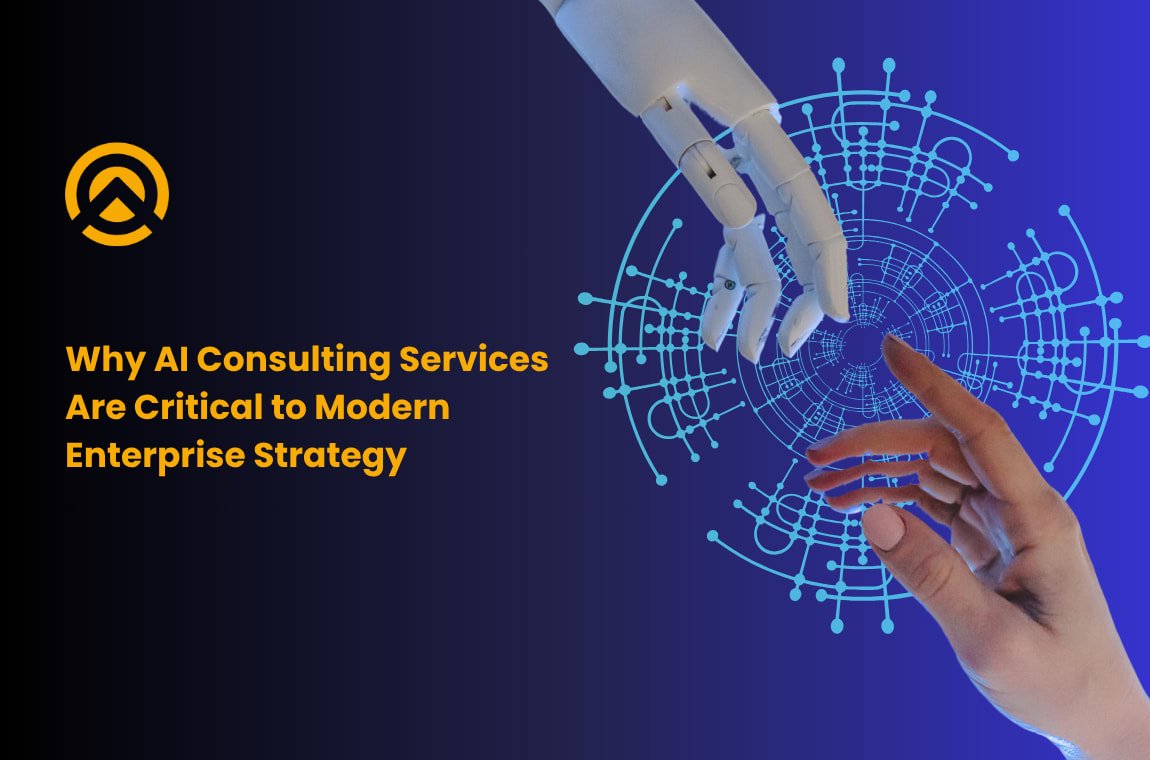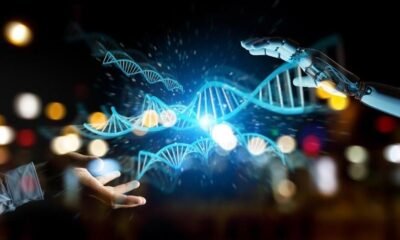In today’s digital-first economy, artificial intelligence (AI) is no longer the stuff of a sci-fi film—it is among the pillars of support in developing a competitive advantage, driving innovations, and enhancing operational efficiency. Enterprise businesses in every industry are now looking towards AI for automating business operations, transforming their business operations, and learning how to deal with their customers. However, implementing AI effectively is less than a matter of buying a tool, as it requires a strategic vision, a profound technical expertise, and a tailored approach. It is where AI consulting solutions truly shine.
AI consulting is the tool to initiate the gap between raw AI technology and measurable business results. It guides the path of enterprises in the world of complex AI ecosystems, selects the most appropriate technologies, creates scalable solutions, and unleashes its ability to make data-driven decisions. Find out why, as a service, AI consulting is the pivot of enterprise strategy in the new world and how it can facilitate ongoing growth and change.
1. AI Is a Strategic Investment, Not Just a Technology Upgrade
Most of the businesses continue to view AI as a plug-and-play solution. The truth is that AI needs strategic planning with business goals and business processes, and business capabilities. Artificial intelligence consultancies guide companies in the ways they can determine their existing growth stage, how they can extract the most value out of AI, and how they may plan an implementation plan.
Be it predictive analytics to better comprehend the customer, the computer vision in manufacturing, or applying NLP domain in a customer service perspective, AI consulting offers a match of solutions to the worlds of applications and industries.
Considering AI as a strategic investment, instead of a one-time technology implementation, companies can achieve long-term ROI on top of the sustainable impact.
2. Customized AI Solutions in Place of One-Size-Fits
Every business is different, with distinct data, distinct workflows, and distinct regulatory constraints. Off-the-shelf AI products rarely achieve an optimum outcome with no customization.
On consultation on the AI schemes, the AI consultants collaborate with the stakeholders in designing, developing, and implementing the tailored AI models for an organization regarding its unique problems and needs. It contains pre-processing of data, selection of models, tuning of the algorithms, testing, and integration with the existing systems.
A consumer business can need demand forecasting with AI, and a health institution can wish for patient risk modeling. An AI developer understands these distinctions and develops tailored products, each better than an off-the-shelf platform.
3. Data Strategy and Infrastructure Are Key to AI Success
Artificial Intelligence is only as good as the data it is being driven with. Yet many companies start with data silos, disparate formats, or inadequate infrastructure.
AI consulting firms provide data strategy guidance, help enterprises build robust data pipelines, put governance policy in place, and modify data architecture for processing real-time analytics and ML workloads.
By developing cloud-based data lakes through implementing ETL (Extract, Transform, Load) operations and data labeling programs, there are guarantees in place for the right groundwork being properly laid in place—therefore, AI initiatives don’t fail due to poor data.
4. Faster Time-to-Value through Expertise and Experience
One of the biggest hurdles in implementing AI is the learning curve. It may take in-house teams a number of years to recruit, train, experiment with models, and home use cases. AI consulting services dramatically reduce time-to-value through the bringing in of cross-functional expertise—data scientists and ML engineers, AI architects, and domain specialists. Their in-the-trenches experience with the same work in other industries serves to avoid common pitfalls and accelerate deployment.
The scaffoldings, frequent pieces, and rapid processes are also offered, and hence experimentation, prototyping, and scale are fast.
5. Mitigating Risk and Promoting Responsible AI
Since the issues of data privacy, bias, transparency, and ethical AI are more apt to increase in the future, institutions should be more cautious in terms of how they design and deploy their AI technologies in the future.
The AI consulting companies are vital in the correct deployment of AI. They assist businesses in:
- Introduce methods for detecting fairness and bias
- Comply with data protection legislation like GDPR or HIPAA
- Create XAI systems with explainability for transparency
- Set up audit trails and monitoring systems for accountability
Responsible AI isn’t compliance, it’s trust, brand value, and long-term loyalty. Enterprise consulting partners enable these principles day one in their AI strategy.
6. AI Consulting Enables Scalable, Future-Proof Architectures
Businesses today demand AI solutions that scale within the business, across regions, departments, or product lines, yet can adapt over time. Partnering with an AI agent development company offering scalable, modular architectures through AI consulting services ensures long-term expansion and adaptability.
Examples include recommendation systems of e-commerce that initially had a single geographic basis and needed to serve users in other languages, regional product trends, growing volumes of data, etc.
The Architecture Artificial Intelligence consultants design cloud-native, API-led, and microservice-based AI solutions that make it possible to continuously learn, combine, and innovate.
7. Driving Digital Transformation through AI as the Enabler
AI is not just a distinct initiative; it is the powertrain for the overall digital transformation. From process automation (through RPA as well as AI) to intelligent decision-making, AI injects intelligence in every function of the enterprise.
- Consulting bodies bring about this transformation with:
-
Integrating AI with business applications (ERP, CRM, SCM, etc.)
- Redrafting business operations in an AI-first manner
- Training the workforce to work with intelligent systems
- Establishing Centers of Excellence (CoEs) for innovation
AI consulting integrates AI into the DNA of the business—not only as a tool, but as an enabler of new business and culture shifts.
8. Filling Talent and Knowledge Gaps
AI talent demand far exceeds supply. It is costly and time-consuming to hire data scientists, ML engineers, and AI strategists.
AI consultancies fill the talent gap with the provision of multidisciplinary teams who can augment in-house talent. Additionally, AI consultancies also provide upskilling training programs, workshops, and mentorship to create independent teams.
Companies can start with the right consulting company instead of setting aside projects due to lack of experience.
9. Continuous Optimization and Tracking
AI models do not set it and forget its services. Requirements are always there to monitor, retrain, and tune models as the data changes and business situations change.
- Consulting partners provide ongoing help, including:
-
Perf0rmance dashboards for
- Drift detection and retraining pipelines for models
- Incorporating the feedback loop for continual learning
- A/B testing and impact analysis
This assures ongoing value for AI systems, regardless of shifting market conditions, consumer behavior, and internal processes.
10. Delivering measurable business impact
The bottom line is, eventually, any AI program is quantifiable in terms of business value: cost decrease, revenue improvement, customer satisfaction, or operational efficiency.
The AI consulting companies match every project against the central performance measures (KPIs) and ensure that the solutions are not only technically right but also deliver real business value.
From defining the right measures of success through installing ROI dashboards, they help the executive track the impact and justify further investment in AI.
Final Words
The situation in the present business environment is that AI is not a luxury but a strategic need. Nevertheless, outsourcing is out of competence with regard to dealing with the complexity of AI implementation. It needs strategic vision, technical skills also as well as domain-based ability, something that is scarce among most companies.
It is here that a transformative power of AI consultancies comes in. They are not only constructing models, but are assisting businesses in transforming their operations, discovering new possibilities, and attaining a sustainable competitive advantage. With the rate at which the world is following technological breakthroughs, only those businesses that collaborate with the most appropriate AI consultancies will be able to shape, innovate, and prosper in the era of digital life.
![[Yonhap News]](https://aistoriz.com/wp-content/uploads/2025/09/news-p.v1.20250831.d71f26a8922c4f6da5d080fdf3ebf6ff_P1.png)
![[Yonhap News]](https://aistoriz.com/wp-content/uploads/2025/09/news-p.v1.20250831.afa375b4a1bd494088f1402e4c83be6c_P1.png)
















































